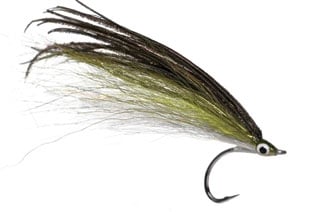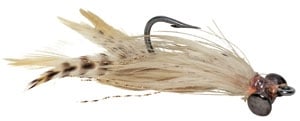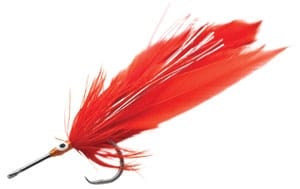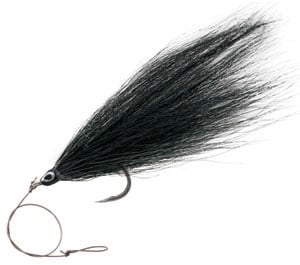
It was a classic bluefish blitz on a pristine autumn day. After catching and releasing several blues, I put the rod aside and picked up the camera while observing other anglers in action.
I noticed several spin fishermen wrestling with treble hooks, long-nose pliers and bluefish teeth. After mangling the fish to a degree, some anglers literally kicked them back into the wash. But one fly-rodder stood out from the rest and made it look easy.
Retrieving blue after blue, she deftly slipped the hook from the marauder’s jaws while leaving the game fish partially submerged. Then she was quickly casting again. I knew immediately she was using a completely debarbed hook.
Barbless Situations
A wild blitz is one event where a debarbed hook pays handsome dividends. When school-size striped bass are easy and abundant during springtime, a barbless hook permits fast releases.
Fishing on jetties and rocks is a tough game – here, a barbless hook takes a measure of difficulty from landing and releasing fish from the rocky structure and generally allows a snagged fly to be worked free. Certainly any fly-fishing newcomer will feel more secure learning jetty techniques while employing a pattern with no barb.
Of course, a barb is designed to penetrate a fish’s mouth and then stay there. Trouble is, it works that way all around. Anyone who fishes hard and long – particularly under adverse conditions – most likely will deal with

hooking their clothing, waders or skin at some time.
A few years ago at the West Wall, a popular Rhode Island jetty, two fly-rodders (at different times) gave me firsthand testimony of regretting to use barbless hooks. Both had tossed weighted patterns in windy conditions, and each had inadvertently hooked his face. The fishermen had used debarbed hooks on prior trips and were convinced that had they been doing so the days they suffered their accidents, the end results would have been much different.
Instead of aborting the fishing trip to have an embedded hook surgically removed, they could have slipped the fly out with much less aggravation, perhaps even avoiding a follow-up visit to a physician. Fortunately, these accidents are infrequent, yet most of us can relate similar stories of when a fly with the barb removed would have lessened the severity of a mishap.
The Best Hooks

The vast majority of all saltwater hooks from all manufacturers come with barbs of varying degrees. Many of these hooks are good candidates to be debarbed.
The best approach is to select tin-plated or stainless-steel hooks that have some semblance of a circle in the bend – whether a circle gape, a saltwater gape or a slight curve leading to the point. For example, the Mustad Circle Streamer C71S SS and the Gamakatsu SC15 series feature a saltwater gape, while a Gamakatsu Big Game SL12S has a reversed bend point.
What’s critical here is that when these styles are debarbed, the angler retains a strong measure of hooking power due to the curve in the bend. Also, crushing or removing the barb on tin-plated or stainless-steel designs does not seem to cause any loss of hook strength, nor does it seem to cause rusting.
Not as viable for debarbing purposes are hooks with a black chrome (or red) finish and those with a perfect or O’Shaughnessy bend. The finish may chip off during the debarbing process, inviting rust and fish refusal. Designs that do not feature the aforementioned hint of a circle in the bend but appear as half circles when viewed from eye level are easier for the fish to spit.
Another bonus to fishing debarbed hooks is that poppers, sliders and streamers are more likely to be kept in pristine condition when releasing fish. I have seen anglers twist and ruin bodies of flies in their lust to rapidly remove a barbed hook from a tough mouth. Had the pattern been debarbed, the fly would have benefited along with the fly-rodderand fish.
Crushing the Barb and Fishing the Fly
Begin by carefully crushing the barb prior to tying the fly. Use pliers with a quarter-inch crushing surface, and strive to push the barb flush with the shank. The objective is to fully flatten the barb, leaving a fairly slight, though smooth, bump in the bend.
At times, the barb may snap off with a distinct sound, leaving about half a barb. This is still similar to a fully barbed hook. It is uncanny how the slightest barb can impede hook removal. Two methods can be used to smooth the remaining barb flat. You can secure the hook in a vise in the normal fly-tying mode and use a round hook file or one with a slim side to carefully file the stub. Dremel-type tools can also be used to remove the burr from the barb. Though it is unlikely any of the shaved barb will fly away, donning safety glasses is nevertheless a prudent move.

When you’re fishing a debarbed fly, it actually becomes easier to hook fish because there is less resistance during the hook-set. Avoid sag in the line during retrieval of the pattern, and once the fish is hooked, keep a tight line to ensure full play of the fish-fighting process. When using offerings with inherent action or when in moving-water situations that promote fly action, a uni-knot or clinch knot provide a more direct connection between the fly and leader versus a loop knot, which gives a fly maximum movement but leaves some play.
It would be foolish to promote fishing debarbed flies all the time. There are situations where different size barbs on various style hooks are more practical and effective overall when left intact. Nevertheless, when deciding to fish barbless, taking the time in advance to consider the most advantageous hook, technique and venue will yield safe, satisfying results.









